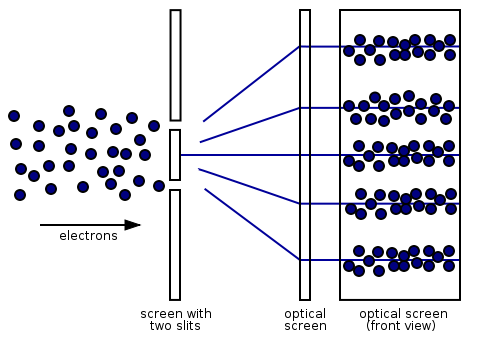The Wave-Particle Duality
The following article is extracted from Chapter VI of the Duality of Time book, and some of the details are discussed further in other chapters, as well as Volume III that is the Ultimate Symmetry.You can also check this
short video, and other videos can be found on the Duality of Time Theory YouTube Chanel.
See also this more complete Logical Interpretation of Quantum Mechanics based on the Duality of Time Theory.
 Everything in the cosmos, as it has been verified by many experiments, is not only waves, and not only particles; while these two concepts are both contrasting and exclusive, at the same time. This means that they can’t together describe the same thing at the same time, and there is no other concept in the current physics apart from waves and particles. Therefore, in order to provide any complete and reasonable interpretation of Quantum Mechanics, we need to explain this wave-particle duality.
Everything in the cosmos, as it has been verified by many experiments, is not only waves, and not only particles; while these two concepts are both contrasting and exclusive, at the same time. This means that they can’t together describe the same thing at the same time, and there is no other concept in the current physics apart from waves and particles. Therefore, in order to provide any complete and reasonable interpretation of Quantum Mechanics, we need to explain this wave-particle duality.
All dualities in nature are the consequence of the continuum and discretuum complementary representation of phenomenological multiplicity, which is an artificial dual exposition of the oneness of metaphysical reality, embodied by the recurrence of the Single Monad that is creating all entities in the world. Consequently, because of this ultimate metaphysical oneness of reality, space-time and matter are essentially discrete but they are still potentially continuous because of its infinite creativity, i.e. its unlimited ability to manifest in ever new forms through the perpetual recurrence of inward and outward time dimensions. As we have seen in chapter III, the concept of “potential infinity” was employed by Aristotle, and it was the only way he could refute Zeno’s paradoxes of motion and plurality.
This means that the future is potentially continuous and infinite, behaving like waves, but as soon it is measured or observed, by becoming in the present and then ceasing into the past, it loses this potentiality and becomes discrete and defined, which is what characterizes the physical particles. On the other hand, events or phenomena which passed into the past have completely ceased out of existence and they cannot be defined regardless whether they have been observed or not, though their effects might still follow at another future instance. Any records or memories of events or effects are treated as new potential continuous existence until the time of their inspection when this potentiality collapses again.
Therefore, according to the Duality of Time, as a result of the continuous creation, multiplicity is revealed through the inner levels of time in which space and matter are dynamically created, and then they evolve over the outer level. Although the reality of time in both levels is discrete, on the inner level, space will appear potentially continuous due to the vast possible manifestations that spread over the three outward dimensions and any other inward curled dimensions that form matter particles. Originally, the real flow of time is infinitesimally continuous because it is a result of the continuous and steady revolution of the Single Monad, but as this Single Monad “turns” from one individual monad to the other, each one individual monad will encounter a discrete interval of time, which is the second level that is encountered outwardly, and that is why it appears imaginary with relation to the previous level. So, on the primary level of time, space is being continuously created, and each instance of the whole space will appear as one point in the secondary level of time, that we normally encounter.
In addition to the computer monitor analogy that we described in chapter IV, as another illustration of this instantaneous creation of space, we can think of the continuous revolution of the Earth that creates days, months and years, so locally time appears continuous, but it is divided globally into days and other discrete periods that are defined only with relation to other celestial objects.
If we suppose that we are inside the Earth without knowing how it is moving in space, we would only encounter continuous existence and continuous time. But if we suppose we are watching the Earth from somewhere far away, with a constant source of light shining on it while it is revolving, we would only see its fluctuation between day and night, which will be interpreted as existence-nonexistence. Now if we suppose many such earths close to each other and extending infinitely in space, they will appear popping in and out of existence at various intervening time durations, so in total they may form some varying patterns that we will describe as a dynamic universe, while in fact they are all created from the superposition of the only two primary states of day and night;
corresponding in our case to existence and non-existence, or
![]() and
and ![]() .
.
Similarly, from our perspectives, being inside the universe, the continuous revolution of the Single Monad is not confined in time, rather: it is what is creating time, by re-creating the individual monads whose existence will appear to us instantaneous, since we are also being re-created. Because we are in the state of existence, we only see things as they are always in existence, so their existence appears to be continuous, but this even physically cannot be true simply because the presence is always being converted into past, and the past does not have any existential reality, neither does the future. What exists of time is only the presence that by definition does not have a duration, i.e. it is zero-time. So in fact existence is always coming to be in zero time, as discrete instances of the of the continuous and infinite real flow of time that is generated by the constant revolution of the Single Monad.
On the level of multiplicity, if anything persisted for a continuous duration of time, no matter how short, it would encounter an infinite number of events with relation to other things, because at any instance of the infinite instances of this continuous short duration there would be some relative motion, otherwise if absolutely nothing changes time would not flow. But if we have infinite number of motions we have infinite energy! Therefore, the Re-creation Principle is the only way to avoid infinity on the level of multiplicity, where we are habitually staying.
However, any kind of measurement or detection necessarily means that the Single Monad at this particular instance of measurement is manifesting as the observer that is now acting on the system, and since there is only one state of existence and one state of nonexistence, at the real flow of time, the system must necessarily collapse into nonexistence, or particle, because at this particular time the observer was taking on the existence state, so the whole observed multiplicity of individual monads must be all in the nonexistence state, at this particular instance of the real time. Of course, as we shall see further in section 9.5, this collapsing is not fatal, otherwise particles and objects will disappear forever, but they are re-created or excited again right after this instantaneous collapse, at which time the observer now would have moved back into an indeterminate state, and become an object amongst other objects.
In other words, the collapse that always happens as a result of measurement or detection, means that the measured entity, which was in the superposition state, i.e. “subject”, has now collapsed into the eigenstate, i.e. “object”, by the “act” of measurement by the observer that has just took over this instance of existence and became the subject at this very real instance of measurement. The whole cosmos is then built on these three entities: “subject-action-object”, or: “energy-force-matter”, or: “wave-operator-particle”, that are three different aspects of the same reality of the Single Monad, that is the only player who is unceasingly performing these three consecutive movements whose outcome would create an individual monad that is nothing but its “shadow” which would act as an object in the next scene. The perpetual recurrence of this three-fold operation results in the accumulation of these shadows or objects that are eventually spread spatially and temporally to make the whole dynamic matter and energy in the cosmos.
In total, therefore, the Single Monad performs seven primary revolutions, because each movement of the above three-fold operation consists of two states of existence-nonexistence, which in total makes the six directions or three dimensions of space, and the seventh revolution is what makes a one directional instance of the outward level of time, and this will be like resetting the instance of space to start anew. In terms of Quantum Field Theory, the first six revolutions create massive particles that becomes localized in space, which will be either the subject or the object depending on which one is current excitation, and the seventh revolution creates a massless particle that is the action or energy. For this reason, energy is directly related to time, while mass is related to space.
Accordingly, the two concepts of waves and particles remain separate and exclusive natures of existence, it is not that particles are associated with waves or vice versa, rather: it is either waves or particles, or: either energy or matter, or: either existence or nonexistence, when they are mixed together and averaged they are observed together in relative ways in our level of space-time, but on the primary level the presence is always energy and the past is mass. Or we can say that the past and the future are vacuum and the presence is always being excited from the future and damped into the past. The difference between the future and the past, both being described as vacuum, is that the past is a “dead vacuum” or “void” while the future is still possible to become present, although not everything is possible to exist, and not everything possible will exist.
List of Some Major Problems Solved by the Duality of Time Theory
In the following articles, we will list some of the major unsolved problems in theoretical physics and describe them in brief, stating their potential solutions according to the Duality of Time Postulate. Although many of these problems will be simply eliminated according to the new genuinely-complex time-time geometry, a detailed theoretical and mathematical analysis is required in order to explain how these problems are settled. Therefore, some of the following brief suggested solutions may be speculative.
These articles are extracted from Chapter III of the Duality of Time book, and some of the details are discussed further in other chapters, as well as Volume III that is the Ultimate Symmetry. A more concise description is also published in Time Chest.
The Duality of Time Postulate
To understand how all these major problems could be solved so easily, please study first the Duality of Time Postulate, that has been extracted from Chapter V of the Duality of Time book.

Solving the Arr...
Solving the Maj...
Selected Favori...
Published Books...
Arabic Articles...
Curriculum Vita...
Welcome to my W...

